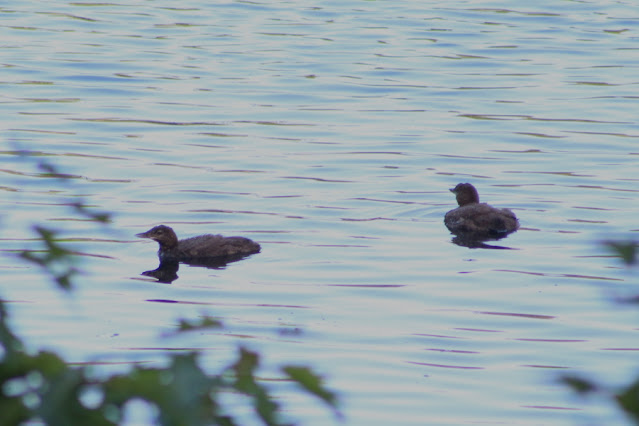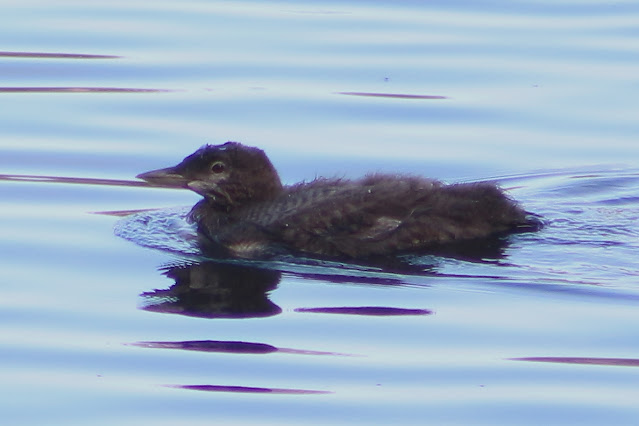Perhaps the one plant that I think most represents a New Hampshire lake is the pond lily. I have seen these small, oval lilies ever since I was a kid, and probably because of their ubiquity, I have never given them much thought until this week when I saw dozens of small, curled red flowers growing up amidst the lily pads.
 |
| It's the small red flower, easily overlooked next to the showy white pond lily. |
 |
| There were actually hundreds of them. (Plus one yellow pond lily.) |
I had no idea what they were. Going straight to my Audubon Field Guide to New England I was surprised not to find it listed within the covers of my most trusted book, so I searched online and immediately identified the flowers as those of the Watershield, which is the correct name for what I always called a water lily, but in fact isn't even in the same family as the water lilies. A key difference between watershield and water lilies is that watershield leaves are oval and lack the cut that gives lilies their heart-shaped leaves.
 |
| Many oval watershields and a few larger water lilies with the heart-shaped cuts in them. |
Also, the stalk of the watershield connects to the center of the oval leaf rather than at the edge like the water lilies.
 |
| Watershield (Brasenia schreberi) |
I also learned that watershield has a unique two-day flowering process. According the Forest Service:
On the first day the bud emerges above the water. Sepals and petals open and bend downward. Although stamens and pistils are present in each flower, on the first day of blooming, only the pistils emerge. Stalks of the pistils lengthen and spread outward over the petals. At night, the flower stalk bends and the flowers submerge beneath the water. On the second day, flowers emerge from the water again, but with the pistils retracted. The stamen stalks are lengthened and the anthers open. In this way flowers are cross-pollinated (Osborn and Schneider). After blooming, the sepals and petals fold up and submerge. Fruit develops underwater enclosed in the petals and sepals. Fruits are leathery and club shaped with one or two seeds each.
I believe the lower, pale pink parts in the center are the retracted pistils, and the stamens are the taller, darker red structures with anthers at the end with yellow pollen on them. This would indicate it's on the second day of blooming. I didn't know enough to look to see if there some flowers that were on their first day. I do learn something new every day.
There were also a couple of interesting insects buzzing around the lake this week, including one I hadn't seen before:
 |
| Summer fishfly (Chauliodes pectinicornis) |
It looks a little beat up, with a damaged wing and missing most of one antenna. The feathery remaining antenna helped with identifying it and also indicates it's a male. That form of antenna is called "pectinate", forming part of its scientific name; cornis means "horns". This fishfly was over two inches long, and it supposedly can give a painful bite with its large front pincers. I didn't test that claim. The fishfly can live several years, but as I've learned about other aquatic insects, much of that life span is under water. Less than seven days is spent out of the water as an adult.
This next insect looks even more menacing, but it's actually harmless.
 |
| Mayfly |
Mayflies are favorite foods of many fish. Birds are happy to feed on these poor-flying insects as well, but they better be quick because an adult mayfly only lives one day, maybe two at the most - that doesn't leave much time to mate and lay eggs back in the lake!
I saved the loon update for last because there's sad news. It appears we have lost both chicks from the southern nest to rogue loons. One was apparently killed last Saturday night, and the other last Sunday; neither has been seen since. On the positive side, despite eagle attacks and rogue loon assaults with violent calling almost every night, the northern pair has proven their mettle, and LuLu and Checkers are still hanging in there!
 |
| LuLu and Checkers are doing fine under the expert supervision of their parents. |
 |
| They're in the stage where they lose their baby feathers and their juvenile chevron pattern starts to show. |
Let's end on a pretty note.
 |
| Bluet damselfly on one of Linda's daylilies |
And now I know what stamens and anthers and pistils are!

Scott! Thanks…always learning…T
ReplyDeleteAre the frogs keeping you awake at night?
ReplyDelete:-) They've actually quieted down lately. Maybe if we get some more really hot nights!
Delete